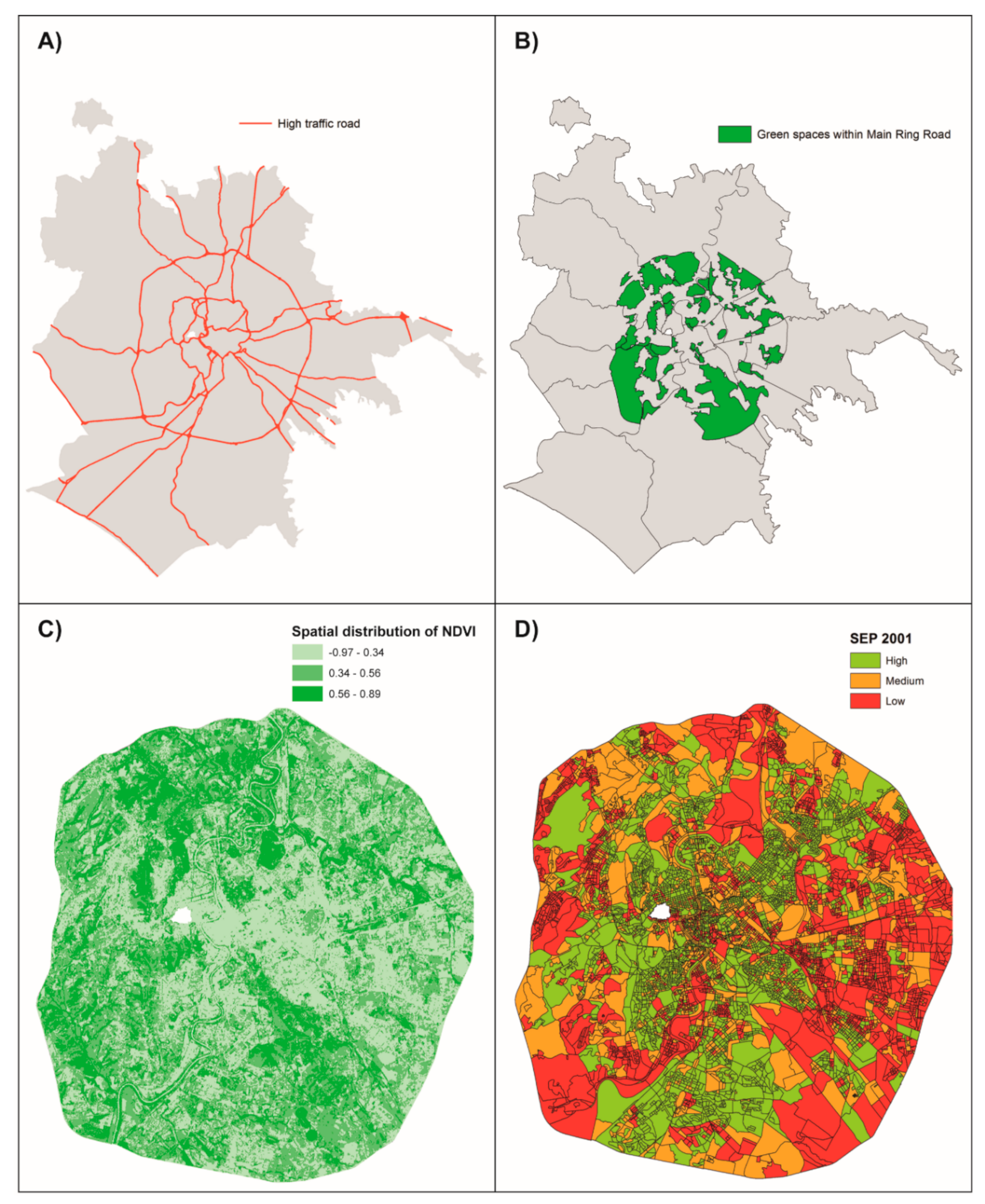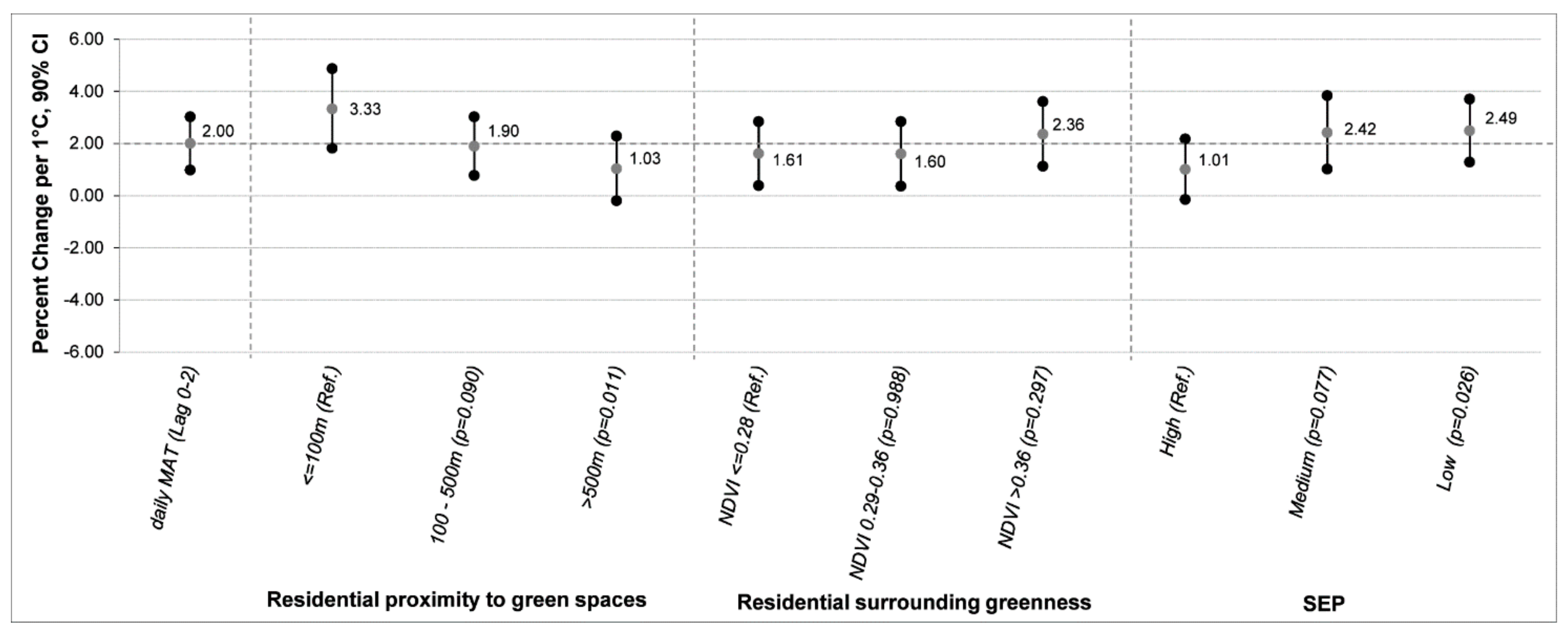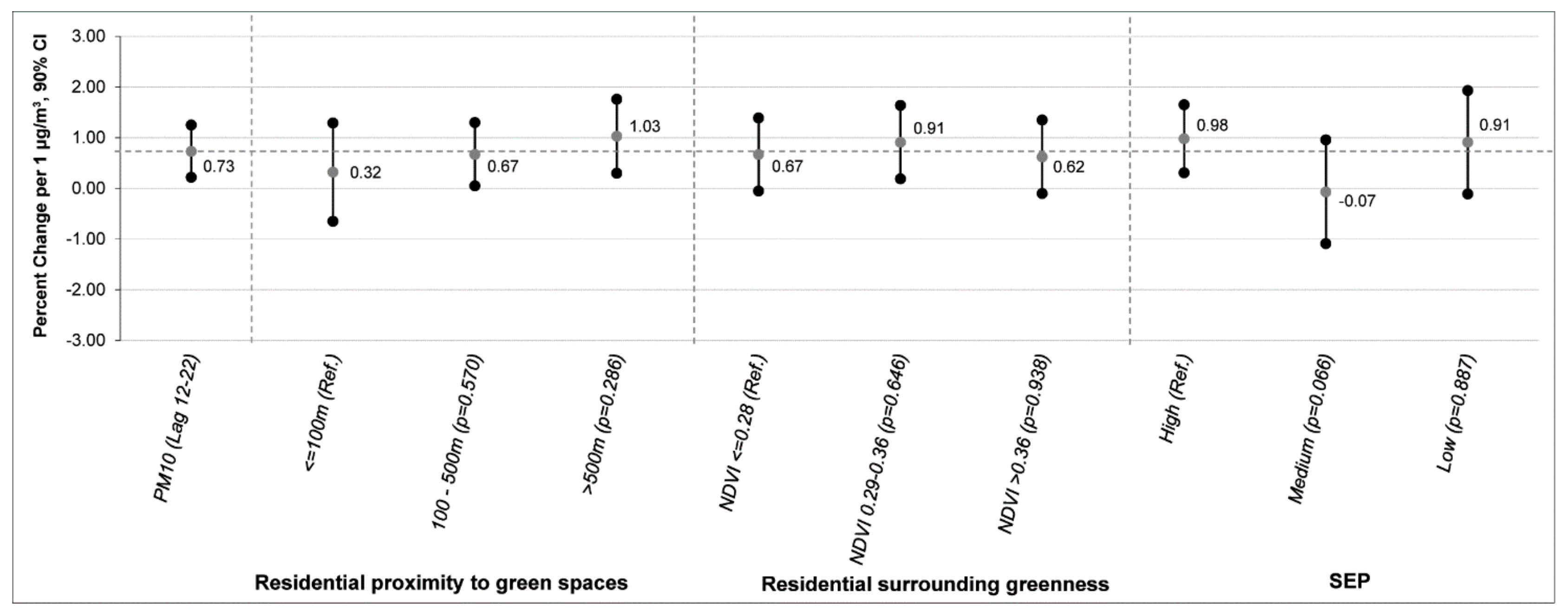The Modifying Role of Socioeconomic Position and Greenness on the Short-Term Effect of Heat and Air Pollution on Preterm Births in Rome, 2001–2013
Abstract
1. Introduction
2. Materials and Methods
2.1. Study Population
2.2. Outcome Definition
2.3. Meteorological Variables and Air Pollution
2.4. Greenness Indicators
2.5. Socioeconomic Position
2.6. Statistical Analysis
3. Results
4. Discussion
5. Conclusions
Supplementary Materials
Author Contributions
Funding
Acknowledgments
Conflicts of Interest
List of Abbreviations
References
- Mathews, T.J.; MacDorman, M.F. Infant mortality statistics from the 2008 period linked birth/infant death data set. Natl. Vital Stat. Rep. 2012, 60, 1–27. [Google Scholar] [PubMed]
- Escobar, G.J.; McCormick, M.C.; Zupancic, J.A.F.; Coleman-Phox, K.; Armstrong, M.A.; Greene, J.D.; Eichenwald, E.C.; Richardson, D.K. Unstudied infants: Outcomes of moderately premature infants in the neonatal intensive care unit. Arch. Dis. Child. 2006, 91, F238–F244. [Google Scholar] [CrossRef] [PubMed]
- Basu, R.; Malig, B.; Ostro, B. High ambient temperature and the risk of preterm delivery. Am. J. Epidemiol. 2010, 172, 1108–1117. [Google Scholar] [CrossRef] [PubMed]
- Kloog, I. Air pollution, ambient temperature, green space and preterm birth. Curr. Opin. Pediatr. 2019, 31, 237–243. [Google Scholar] [CrossRef] [PubMed]
- Strauss, J.F.; Romero, R.; Gomez-Lopez, N.; Haymond-Thornburg, H.; Modi, B.P.; Teves, M.E.; Pearson, L.N.; York, T.P.; Schenkein, H.A. Spontaneous Preterm Birth: Advances Toward the Discovery of Genetic Predisposition; Elsevier Inc.: Amsterdam, The Netherlands, 2018; Volume 218, ISBN 2752013000. [Google Scholar]
- Goldenberg, R.L.; Culhane, J.F.; Iams, J.D.; Romero, R. Epidemiology and causes of preterm birth. Lancet 2008, 371, 75–84. [Google Scholar] [CrossRef]
- Lawn, J.E.; Gravett, M.G.; Nunes, T.M.; Rubens, C.E.; Stanton, C. Global report on preterm birth and stillbirth (1 of 7): Definitions, description of the burden and opportunities to improve data. BMC Pregnancy Childbirth 2010, 10. [Google Scholar] [CrossRef]
- Beltran, A.J.; Wu, J.; Laurent, O. Associations of meteorology with adverse pregnancy outcomes: A systematic review of preeclampsia, preterm birth and birth weight. Int. J. Environ. Res. Public Health 2013, 11, 91–172. [Google Scholar] [CrossRef]
- Vicedo-Cabrera, A.M.; Iñíguez, C.; Barona, C.; Ballester, F. Exposure to elevated temperatures and risk of preterm birth in Valencia, Spain. Environ. Res. 2014, 134, 210–217. [Google Scholar] [CrossRef]
- Vicedo-Cabrera, A.M.; Olsson, D.; Forsberg, B. Exposure to seasonal temperatures during the last month of gestation and the risk of preterm birth in stockholm. Int. J. Environ. Res. Public Health 2015, 12, 3962–3978. [Google Scholar] [CrossRef]
- Zhang, Y.; Yu, C.; Wang, L. Temperature exposure during pregnancy and birth outcomes: An updated systematic review of epidemiological evidence. Environ. Pollut. 2017, 225, 700–712. [Google Scholar] [CrossRef]
- Carolan-Olah, M.; Frankowska, D. High environmental temperature and preterm birth: A review of the evidence. Midwifery 2014, 30, 50–59. [Google Scholar] [CrossRef] [PubMed]
- Brauer, M.; Lencar, C.; Tamburic, L.; Koehoorn, M.; Demers, P.; Karr, C. A cohort study of traffic-related air pollution impacts on birth outcomes. Environ. Health Perspect. 2008. [Google Scholar] [CrossRef] [PubMed]
- Backes, C.H.; Nelin, T.; Gorr, M.W.; Wold, L.E. Early life exposure to air pollution: How bad is it? Toxicol. Lett. 2013, 216, 47–53. [Google Scholar] [CrossRef] [PubMed]
- Strand, L.B.; Barnett, A.G.; Tong, S. The influence of season and ambient temperature on birth outcomes: A review of the epidemiological literature. Environ. Res. 2011, 111, 451–462. [Google Scholar] [CrossRef] [PubMed]
- Sapkota, A.; Chelikowsky, A.P.; Nachman, K.E.; Cohen, A.J.; Ritz, B. Exposure to particulate matter and adverse birth outcomes: A comprehensive review and meta-analysis. Air Qual. Atmos. Heal. 2012, 5, 369–381. [Google Scholar] [CrossRef]
- Stieb, D.M.; Chen, L.; Eshoul, M.; Judek, S. Ambient air pollution, birth weight and preterm birth: A systematic review and meta-analysis. Environ. Res. 2012, 117, 100–111. [Google Scholar] [CrossRef]
- O’Neill, M.S.; Osornio-Vargas, A.; Buxton, M.A.; Sánchez, B.N.; Rojas-Bracho, L.; Castillo-Castrejon, M.; Mordhukovich, I.B.; Brown, D.G.; Vadillo-Ortega, F. Air pollution, inflammation and preterm birth in Mexico City: Study design and methods. Sci. Total Environ. 2013, 448, 79–83. [Google Scholar] [CrossRef]
- Vadillo-Ortega, F.; Osornio-Vargas, A.; Buxton, M.A.; Sánchez, B.N.; Rojas-Bracho, L.; Viveros-Alcaráz, M.; Castillo-Castrejón, M.; Beltrán-Montoya, J.; Brown, D.G.; O’Neill, M.S. Air pollution, inflammation and preterm birth: A potential mechanistic link. Med. Hypotheses 2014, 82, 219–224. [Google Scholar] [CrossRef]
- Shah, P.S.; Balkhair, T. Air pollution and birth outcomes: A systematic review and on behalf of Knowledge Synthesis Group on Determinants of Preterm/LBW births. Environ. Int. 2011, 37, 498–516. [Google Scholar] [CrossRef]
- Lee, S.J.; Hajat, S.; Steer, P.J.; Filippi, V. A time-series analysis of any short-term effects of meteorological and air pollution factors on preterm births in London, UK. Environ. Res. 2008, 106, 185–194. [Google Scholar] [CrossRef]
- Schifano, P.; Lallo, A.; Asta, F.; De Sario, M.; Davoli, M.; Michelozzi, P. Effect of ambient temperature and air pollutants on the risk of preterm birth, Rome 2001–2010. Environ. Int. 2013, 61, 77–87. [Google Scholar] [CrossRef] [PubMed]
- Pickett, K.E.; Pearl, M. Multilevel analyses of neighbourhood socioeconomic context and health outcomes: A critical review. J. Epidemiol. Commun. Health 2001, 55. [Google Scholar] [CrossRef] [PubMed]
- Samet, J.M.; White, R.H. Urban air pollution, health, and equity. J. Epidemiol. Commun. Health 2004, 58, 3–5. [Google Scholar] [CrossRef] [PubMed]
- Laurent, O.; Bard, D.; Filleul, L.; Segala, C. Effect of socioeconomic status on the relationship between atmospheric pollution and mortality. J. Epidemiol. Commun. Health 2007, 61. [Google Scholar] [CrossRef] [PubMed]
- Dadvand, P.; Wright, J.; Martinez, D.; Basagaña, X.; McEachan, R.R.C.; Cirach, M.; Gidlow, C.J.; de Hoogh, K.; Gražulevičiene, R.; Nieuwenhuijsen, M.J. Inequality, green spaces, and pregnant women: Roles of ethnicity and individual and neighbourhood socioeconomic status. Environ. Int. 2014, 71, 101–108. [Google Scholar] [CrossRef] [PubMed]
- Ross, C.E.; Mirowsky, J. Neighborhood Socioeconomic Status and Health: Context or Composition? City Commun. 2008, 7, 163–179. [Google Scholar] [CrossRef]
- Markevych, I.; Schoierer, J.; Hartig, T.; Chudnovsky, A.; Hystad, P.; Dzhambov, A.M.; de Vries, S.; Triguero-Mas, M.; Brauer, M.; Nieuwenhuijsen, M.J.; et al. Exploring pathways linking greenspace to health: Theoretical and methodological guidance. Environ. Res. 2017, 158, 301–317. [Google Scholar] [CrossRef]
- Kalkstein, L.S.; Valimont, K.M. An Evaluation of Summer Discomfort in the United State Using a Relative Climatological Index. Bull. Am. Meteorol. Soc. 1986. [Google Scholar] [CrossRef]
- O’Neill, M.S.; Zanobetti, A.; Schwartz, J. Modifiers of the temperature and mortality association in seven US cities. Am. J. Epidemiol. 2003, 157, 1074–1082. [Google Scholar] [CrossRef]
- Doick, K.J.; Peace, A.; Hutchings, T.R. The role of one large greenspace in mitigating London’s nocturnal urban heat island. Sci. Total Environ. 2014, 493, 662–671. [Google Scholar] [CrossRef]
- Dzhambov, A.M.; Dimitrova, D.D.; Dimitrakova, E.D. Association between residential greenness and birth weight: Systematic review and meta-analysis. Urban For. Urban Green. 2014, 13, 621–629. [Google Scholar] [CrossRef]
- McEachan, R.R.C.; Prady, S.L.; Smith, G.; Fairley, L.; Cabieses, B.; Gidlow, C.; Wright, J.; Dadvand, P.; van Gent, D.; Nieuwenhuijsen, M.J. The association between green space and depressive symptoms in pregnant women: Moderating roles of socioeconomic status and physical activity. J. Epidemiol. Commun. Health 2016, 70, 253–259. [Google Scholar] [CrossRef] [PubMed]
- Abelt, K.; McLafferty, S. Green streets: Urban green and birth outcomes. Int. J. Environ. Res. Public Health 2017, 14, 771. [Google Scholar] [CrossRef] [PubMed]
- WHO. Urban Green Spaces and Health; WHO: Copenhagen, Denmark, 2016; Volume 80. [Google Scholar]
- Weier, J.; Herring, D. Measuring Vegetation (NDVI & EVI): Feature Articles Measuring Vegetation (NDVI & EVI): Feature Articles; NASA Earth Observatory: Washington, DC, USA, 2011.
- Payam, D.; Jordi, S.; Xavier, B.; Ferran, B.; Aitana, L.; Ana, F.-S.; Marisa, E.; Raquel, G.-E.; Michelle A., M.; Mark, J. Nieuwenhuijsen surrounding greenness and pregnancy outcomes in four spanish birth cohorts. Environ. Health Perspect. 2012, 120, 1481–1487. [Google Scholar]
- Dadvand, P.; Villanueva, C.M.; Font-Ribera, L.; Martinez, D.; Basagaña, X.; Belmonte, J.; Vrijheid, M.; Gražulevičienė, R.; Kogevinas, M.; Nieuwenhuijsen, M.J. Risks and benefits of green spaces for children: A cross-sectional study of associations with sedentary behavior, obesity, asthma, and allergy. Environ. Health Perspect. 2014. [Google Scholar] [CrossRef]
- Hystad, P.; Davies, H.W.; Frank, L.; Van Loon, J.; Gehring, U.; Tamburic, L.; Brauer, M. Residential greenness and birth outcomes: Evaluating the influence of spatially correlated built-environment factors. Environ. Health Perspect. 2014. [Google Scholar] [CrossRef] [PubMed]
- Orioli, R.; Antonucci, C.; Scortichini, M.; Cerza, F.; Marando, F.; Ancona, C.; Manes, F.; Davoli, M.; Michelozzi, P.; Forastiere, F.; et al. Exposure to residential greenness as a predictor of cause-specific mortality and stroke incidence in the Rome Longitudinal Study. Environ. Health Perspect. 2019, 127. [Google Scholar] [CrossRef]
- Cesaroni, G.; Badaloni, C.; Romano, V.; Donato, E.; Perucci, C.A.; Forastiere, F. Socioeconomic position and health status of people who live near busy roads: The Rome Longitudinal Study (RoLS). Environ. Health 2010, 9, 1–12. [Google Scholar] [CrossRef]
- Kelly, A.J.; Malik, S.; Smith, L.; Kavanagh, J.; Thomas, J. Vaginal prostaglandin (PGE2 and PGF2a) for induction of labour at term. Cochrane Database Syst. Rev. 2009. [Google Scholar] [CrossRef]
- Lee, S.E.; Park, I.S.; Romero, R.; Yoon, B.H. Amniotic fluid prostaglandin F2 increases even in sterile amniotic fluid and is an independent predictor of impending delivery in preterm premature rupture of membranes. J. Matern. Neonatal Med. 2009. [Google Scholar] [CrossRef]
- Stan, C.M.; Boulvain, M.; Pfister, R.; Hirsbrunner-Almagbaly, P. Hydration for treatment of preterm labour. Cochrane Database Syst. Rev. 2013. [Google Scholar] [CrossRef] [PubMed]
- Veras, M.M.; Damaceno-Rodrigues, N.R.; Caldini, E.G.; Ribeiro, A.A.C.M.; Mayhew, T.M.; Saldiva, P.H.N.; Dolhnikoff, M. Particulate urban air pollution affects the functional morphology of mouse placenta1. Biol. Reprod. 2008, 79, 578–584. [Google Scholar] [CrossRef] [PubMed]
- Kabisch, N.; van den Bosch, M.; Lafortezza, R. The health benefits of nature-based solutions to urbanization challenges for children and the elderly—A systematic review. Environ. Res. 2017, 159, 362–373. [Google Scholar] [CrossRef] [PubMed]
- Glazer, K.B.; Eliot, M.N.; Danilack, V.A.; Carlson, L.; Phipps, M.G.; Dadvand, P.; Savitz, D.A.; Wellenius, G.A. Residential green space and birth outcomes in a coastal setting. Environ. Res. 2018, 163, 97–107. [Google Scholar] [CrossRef] [PubMed]
- Hondula, D.M.; Davis, R.E.; Georgescu, M. Clarifying the connections between green space, urban climate, and heat-related mortality. Am. J. Public Health 2018, 108, S62–S63. [Google Scholar] [CrossRef] [PubMed]
- Takebayashi, H. Influence of urban green area on air temperature of surrounding built-up area. Climate 2017, 5, 60. [Google Scholar] [CrossRef]
- Zanobetti, A.; O’Neill, M.S.; Gronlund, C.J.; Schwartz, J.D. Susceptibility to mortality in weather extremes: Effect modification by personal and small-area characteristics. Epidemiology 2013, 24, 809–819. [Google Scholar] [CrossRef] [PubMed]
- Dadvand, P.; Basagaña, X.; Sartini, C.; Figueras, F.; Vrijheid, M.; de Nazelle, A.; Sunyer, J.; Nieuwenhuijsen, M.J. Climate extremes and the length of gestation. Environ. Health Perspect. 2011, 119, 1449–1453. [Google Scholar] [CrossRef]
- Lee, A.C.K.; Maheswaran, R. The health benefits of urban green spaces: A review of the evidence. J. Public Health 2011, 33, 212–222. [Google Scholar] [CrossRef]
- Mitchell, R.; Astell-Burt, T.; Richardson, E.A. A comparison of green space indicators for epidemiological research. J. Epidemiol. Commun. Health 2011, 65, 853–858. [Google Scholar] [CrossRef]



| Variable | Entire Cohort n (%) | Residential Proximity to Green Spaces | Residential Surrounding Greenness | ||||
|---|---|---|---|---|---|---|---|
| ≤100 m n (%) | 100–500 m n (%) | >500 m n (%) | NDVI T1 (≤0.28) n (%) | NDVI T2 (0.29–0.36) n (%) | NDVI T3 (>0.36) n (%) | ||
| Study population | 56,576 | 9013 (15.9) | 28,946 (51.2) | 18,617 (32.9) | 19,115 (33.8) | 19,239 (34.0) | 18,222 (32.2) |
| Preterm birth | 2910 (5.1) | 487 (5.4) | 1491 (5.2) | 932 (5.0) | 989 (5.2) | 944 (4.9) | 977 (5.1) |
| Maternal Age (years) | |||||||
| <30 | 13,644 (24.1) | 2156 (23.9) | 6850 (23.7) | 4638 (24.9) | 4590 (24.0) | 4608 (24.0) | 4446 (24.4) |
| 30–36 | 30,485 (53.9) | 4846 (53.8) | 15,707 (54.3) | 9932 (53.4) | 10,315 (54.0) | 10,443 (54.3) | 9727 (53.4) |
| ≥37 | 12,447 (22.0) | 2011 (22.3) | 6389 (22.1) | 4047 (21.7) | 4210 (22.0) | 4188 (21.8) | 4049 (22.2) |
| Education Level | |||||||
| Primary school | 18,660 (33.0) | 2899 (32.2) | 9426 (32.6) | 6335 (34.0) | 6429 (33.6) | 6343 (33.0) | 5888 (32.3) |
| High school | 24,268 (42.9) | 3936 (43.7) | 12,329 (42.6) | 8003 (43.0) | 8022 (42.0) | 8415 (43.7) | 7831 (43.0) |
| Degree | 13,648 (24.1) | 2178 (24.2) | 7191 (24.8) | 4279 (23.0) | 4664 (24.4) | 4481 (23.3) | 4503 (24.7) |
| Socioeconomic position | |||||||
| High | 23,795 (42.1) | 3924 (43.5) | 13,384 (46.2) | 6484 (34.8) | 7347 (38.4) | 7704 (40.0) | 8744 (48.0) |
| Medium | 12,349 (21.8) | 1985 (22.0) | 5972 (20.6) | 4392 (23.6) | 4862 (25.4) | 3804 (19.8) | 3683 (20.2) |
| Low | 20,432 (36.1) | 3104 (34.4) | 9590 (33.1) | 7738 (41.6) | 6906 (36.1) | 7731 (40.2) | 5795 (31.8) |
| Exposure | Min | 25° pctl | 50° pctl | 75° pctl | Max |
|---|---|---|---|---|---|
| Warm Season (April–October) | |||||
| Meteorological | |||||
| daily maximum apparent temperature (°C) | 4.1 | 20.6 | 25.8 | 30.9 | 39.7 |
| Air pollution | |||||
| PM10 (μg/m3) | 7.0 | 24.0 | 30.3 | 38.0 | 181.7 |
| Ozone (μg/m3) | 7.7 | 78.6 | 94.8 | 111.4 | 199.2 |
| NO2 (μg/m3) | 11.9 | 42.1 | 53.0 | 63.5 | 110.1 |
| Environmental Exposures a | % Change per Unit Increase (90% CI) | % Change per IQR (90% CI) | IQR |
|---|---|---|---|
| Warm Season (April–October) | |||
| MAT (Daily maximum apparent temperature) (Lag 0–2) b | 2.00 (0.98, 3.03) | 22.74 (10.59, 36.21) | 10.3 |
| Air pollutants c | |||
| PM10 (μg/m3) (Lag 12–22) | 0.73 (0.22, 1.25) | 8.16 (2.38, 14.26) | 10.7 |
| Ozone (μg/m3) (Lag 0–2) | 0.03 (−0.19, 0.25) | 0.53 (−3.40, 4.61) | 30.4 |
| NO2 (μg/m3) (Lag 0–2) | 0.20 (−0.14, 0.55) | 6.39 (−4.27, 18.22) | 18.2 |
© 2019 by the authors. Licensee MDPI, Basel, Switzerland. This article is an open access article distributed under the terms and conditions of the Creative Commons Attribution (CC BY) license (http://creativecommons.org/licenses/by/4.0/).
Share and Cite
Asta, F.; Michelozzi, P.; Cesaroni, G.; De Sario, M.; Badaloni, C.; Davoli, M.; Schifano, P. The Modifying Role of Socioeconomic Position and Greenness on the Short-Term Effect of Heat and Air Pollution on Preterm Births in Rome, 2001–2013. Int. J. Environ. Res. Public Health 2019, 16, 2497. https://doi.org/10.3390/ijerph16142497
Asta F, Michelozzi P, Cesaroni G, De Sario M, Badaloni C, Davoli M, Schifano P. The Modifying Role of Socioeconomic Position and Greenness on the Short-Term Effect of Heat and Air Pollution on Preterm Births in Rome, 2001–2013. International Journal of Environmental Research and Public Health. 2019; 16(14):2497. https://doi.org/10.3390/ijerph16142497
Chicago/Turabian StyleAsta, Federica, Paola Michelozzi, Giulia Cesaroni, Manuela De Sario, Chiara Badaloni, Marina Davoli, and Patrizia Schifano. 2019. "The Modifying Role of Socioeconomic Position and Greenness on the Short-Term Effect of Heat and Air Pollution on Preterm Births in Rome, 2001–2013" International Journal of Environmental Research and Public Health 16, no. 14: 2497. https://doi.org/10.3390/ijerph16142497
APA StyleAsta, F., Michelozzi, P., Cesaroni, G., De Sario, M., Badaloni, C., Davoli, M., & Schifano, P. (2019). The Modifying Role of Socioeconomic Position and Greenness on the Short-Term Effect of Heat and Air Pollution on Preterm Births in Rome, 2001–2013. International Journal of Environmental Research and Public Health, 16(14), 2497. https://doi.org/10.3390/ijerph16142497





